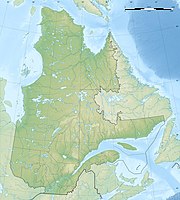Réserve écologique Marcel-Léger
|
Réserve écologique Marcel-Léger
|
||
|
Île aux stars |
||
| location | Trois-Rivières , Quebec, Canada | |
| surface | 0.36 km² | |
| WDPA ID | 18677 | |
| Geographical location | 46 ° 17 ′ N , 72 ° 38 ′ W | |
|
|
||
| Setup date | 1981 | |
| administration | MDDEP | |
The Réserve écologique Marcel-Léger is an ecological reserve on the outskirts of Trois-Rivières in the Canadian province of Québec .
The reserve was established in 1981 under the name Réserve écologique de l'Île-aux-Sternes on an area of 35.5 hectares. The entire Île aux Sternes in the Saint Lawrence River , an artificial island created in 1967 from the overburden of Port-Saint-François, on which the ruderal vegetation is observed, is under protection . The protected area was established on the occasion of the 25th anniversary of the Ministry of the Environment and since 2002 has been named after Marcel Léger (1930–1993), the first minister in office from 1976 to 1981. He was also co-founder of nationaliste Parti du Québec , President of the Acadians -Föderation in Quebec and director of the French-Canadian section of Amnesty International .
The island reaches a height of up to 6 m above the river. The subsoil of the island consists of fine sediments from the Champlain Sea . Plants and animals have been settling on the artificial island for over 40 years, with a completely different development on the majority of the island, which is flooded in spring, than on the higher part, which is not affected by flooding. Inventories were first carried out in 1970, 1972 and 1974. Branchy hedgehog's cob , broad-leaved arrowhead ( Sagittaria latifolia ) and Scirpus americanus were soon found . Young forests emerged, dominated by saule noir, as Salix nigra is called from the species of willow in Québec. Reed grass (Phalaris arundinacea L.) and Calamagrostis canadensis , also called Canada bluejoint or Calamagrostis du Canada , thrive on the permanently dry sections of the island . An endangered or threatened species was also found on the island, namely Strophostyles helvula , also known as trailing wild bean .
The island, being on one of the most important routes for migratory birds, has developed into a refuge for various water birds. In addition to seagulls, these include numerous waders and common terns .
Web links
- Réserve écologique Marcel-Léger , government website
- Regulation respecting the Réserve écologique Marcel-Léger, RRQ, c C-61.01, r 42 , CanLII Databases of the Federation of Law Societies of Canada


